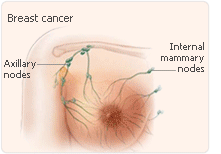
A woman's exposure to estrogen hormones can determine her risk of breast cancer. The more estrogen hormones she has, the greater her chance of developing breast cancer is. Thus, the more menstrual periods a woman has also determines her risk of developing breast cancer. It is believed that exercise and long term physical activity can reduce the amounts of menstrual periods a woman has so in theory, participation in long term physical activity can also reduce the risk of breast cancer. To test out this hypothesis, this study has been performed using data collected from the California Teacher's Study.
Members of the California Teacher's Study was used to determine the association between recreational physical activity and the risk of invasive and situ breast cancer. Invasive cancer breaks through the normal breast tissue barrier and spreads to surrounding areas in the breast and possibly to other parts of the body. Situ breast cancer is non-invasive meaning the cancer cells stay in the same place without spreading to surrounding tissues in the breast or other areas of the body.
Measures of Recreation Physical Activity

From the California Teacher's Study, 110,599 women aged 20 - 79 years participated. They had no record of breast cancer at baseline and were studied from 1995 - 2002. They gave information of personal participation/involvement of strenuous and moderate recreational activities during the menstrual periods from the time of high school until the age of 54. Examples of moderate activities included brisk walking, golf and volleyball while strenuous activities included swimming laps, aerobics, running and jogging. They also reported participation levels in terms of weeks, months and years.
Breast Cancer Risk Factors
Participants also reported data of breast cancer risk factors including family history of breast cancer, race, reproductive history, regularity of menstrual periods, menopausal status, age at menarche, use of hormones therapy and oral contraceptives, weight, height, diet smoking status and alcohol consumption.
Women were considered premenopausal if they had menstrual periods during baseline, peri menopausal if menstrual periods stopped within six months of baseline and post menopausal if menstrual periods had stopped 6 months earlier to vaseline.
Analysis
Two different models were used to evaluate the relationship between physical activity and invasive and in situ breast cancer.
After all the data was collected for this survey, it can be concluded that physical activity may actually lower the risk of breast cancer. This occurs because physical activity limits the amounts of menstrual periods and estrogen hormones exposure, which can cause breast cancer.